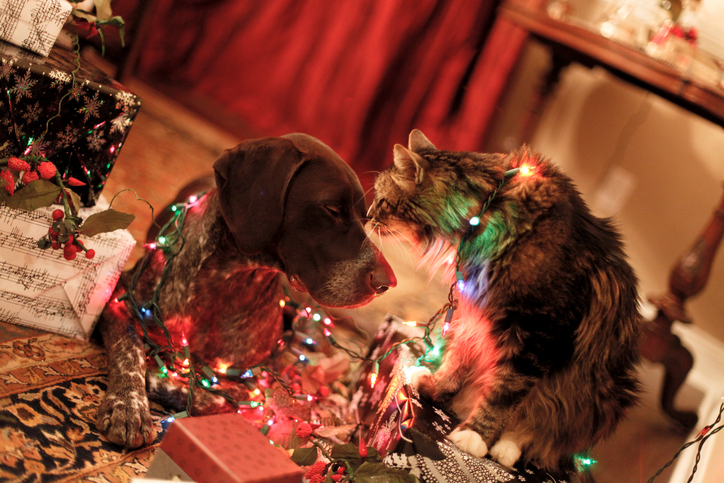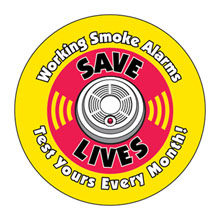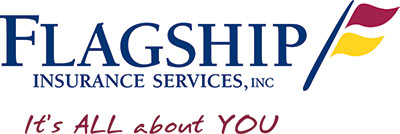
by Flagship Staff | Dec 24, 2016 | Blog
Between giving gifts, preparing large meals, and planning family gatherings, the holidays can be a stressful time of year. Adding another thing to think about may seem overwhelming, but home safety is an important consideration. A devastating burglary, expensive electrical fire, or messy burst pipe is the last thing anyone wants to deal with — or pay for — during the holidays.
Be cautious this holiday season to ensure you don’t encounter any dangerous situations or lose any of your home’s value.
Here are six holiday safety tips to protect your home:
1. Avoid visible gift displays.
People have many new, high-value items wrapped up in their homes around the holidays that burglars can easily and quickly grab—causing potential damage to windows, doors, and a home’s interior and exterior in the process. Police are unlikely to track down a thief and find your gifts: about 87 percent of burglaries go unsolved because of a lack of witnesses and evidence.
Though it’s tempting to set up a picturesque holiday vignette of a Christmas tree surrounded by piles of gifts near your front window, the Los Angeles Police Department encourages people to put presents out of view from windows and doors. Better yet, keep expensive gifts hidden until you’re ready to give them
2. Pick a fresh tree and water it daily.
Christmas trees cause an average of 210 fires and $17.5 million in property damage a year. To avoid this, choose the freshest tree possible. The National Christmas Tree Association recommends running a branch through your fingers to check for signs of dryness. Do not buy a tree if its needles come off easily, its branches break, it has discolored foliage, it smells musty, or its bark is wrinkled. After bringing your tree home and putting it in a stand, check its water level frequently to make sure it doesn’t go below the base of the tree—otherwise, your tree may begin to dry out. And remember any sources of heat, like tree lights, fireplaces, heating vents or sunlight from a window, will cause a tree to dry out more quickly.
3. Choose your lights carefully.
Electrical issues are behind a third of Christmas tree fires, and the majority of those fires involve decorative lights. Consumer Reports cautions to only use lights tested in a nationally-recognized laboratory, like Underwriters Laboratory (UL). Old lights, especially if they are uncertified or damaged, generally draw more power and are a major risk.
The best lights for Christmas trees are certified miniature lights that emit low heat. But no matter what lights you use, always inspect them for loose connections, broken or cracked sockets, and frayed or bare wires. And never leave a lit Christmas tree unmonitored — turn off the tree lights when you leave the house or go to bed.
4. Prevent outdoor light displays from overheating.
Though it’s easy to plug numerous strings of lights together to wrap around the roof, this can cause a major fire hazard. Overloading a single electrical outlet with too many lights will overdraw the power and cause overheating. This can trip the circuit breaker and start an electrical fire.
Prevent this from happening by never attaching more than three strands of lights together. Consider using LED lights, because they use less energy and don’t get as hot as traditional incandescent lights. And, if you’re hanging up lights outdoors, make sure to use ones that are certified for outdoor use
5. Drain outdoor pipes and insulate indoor ones.
During cold winter nights, the water in pipes can freeze and cause them to burst, which may cost up to $6,000 to repair. To avoid an expensive cleanup, take preventative action. Outdoor pipes like sprinkler lines, hose bibs, and swimming pool supply lines are the most likely to freeze. Before cold weather hits, drain the water from your sprinkler lines and swimming pool, remove outdoor hoses, and close the inside valve to outdoor hose bibs.
Unheated interior areas, like basements, garages, kitchen cabinets, crawl spaces and attics, are also at risk. Pipes in these areas need to be insulated with pipe sleeves, heat tape or heat cables that are certified to cover exposed pipes. The American Red Cross advises that even one-quarter inch of newspaper can provide insulation.
6. Keep an eye on all food being cooked.
Cooking mishaps cause nearly 72 percent of Thanksgiving Day fires, leading to $28 million in property loss. The number of kitchen fires on Thanksgiving is more than twice the amount of fires on other days of the year, and turkey fryers alone have caused $8 million in property damage.
The American Red Cross recommends cooks should never leave food unattended and avoid wearing loose-fitting clothing and long sleeves. Also, enforce a “kid-free zone,” use a timer, install a smoke alarm, and keep cooking areas free of items that can catch fire, like oven mitts and towels.

by Flagship Staff | Dec 12, 2016 | Blog
As much as we love our pets, we do our best to protect them from danger all year long — and around the holidays there are special circumstances that put them at risk.
Many of these are obvious, but others are not — and that’s not even considering the anguish of watching a beloved pet suffer. In addition, the challenge of paying for expensive vet care to put right something that could have been avoided to begin with is no way to spend the holidays.
10. Toxic foods
Aside from the tummy upsets to be had from guests sneaking Fido too many treats under the table or Fluffy stealing off with a choice morsel from the kitchen counter, foods that can actually poison your pet are more common around the holidays.
Beware chocolate, particularly dark chocolate; unbaked bread dough; macadamia nuts; turkey; alcohol; fruit cake; raisins; sugar-free candy; and baked goods that include artificial sweeteners.
9. Hazardous decorations
Even full-grown dogs and cats can be prone to the dangers presented by Thanksgiving and Yule decorations, with puppies and kittens that much more so. Cats may be tempted to climb the Christmas tree or sample the poinsettia, holly or mistletoe, while dogs — puppies, particularly — may be curious enough to chew on anything from ornaments to plugged-in holiday lights.
Tinsel and pine needles can be deadly, too, as can water drunk from the tree stand. Make sure pets are kept away from decorations that can prove too tempting, and provide them plenty of fresh safe drinking water located far from the tree.
8. Guest appearances
No matter how much you love your relatives, sometimes they just aren’t pet people — or, conversely, they love them too much. Beware of small (screaming) children who can traumatize pets (and who can get knocked down or bitten if they push pets too far, which will also cause problems with their parents), and people who insist on feeding pets unsuitable treats, or too many treats, or empty the fish food container into the aquarium. And then of course there’s Uncle Rick, who thinks it’s funny to slip your dog a Scotch.
Not to mention that a constant stream of foot traffic in and out of the house can upset pets used to a quiet household. They might even take flight through one of the frequently-opening doors, which could lead to disaster — they could freeze, be hit by a car or get thoroughly lost. If your pet isn’t microchipped, you should give consider having it done before the holidays are much farther advanced.
7. Guests’ possessions
Think prescription drugs and personal care products brought by overnight guests — not to mention that secret stash of snacks or potent potables in Cousin George’s luggage.
Make sure the luggage, the secret stash, the medications and the drinks are safely protected from pet predations, lest the joyful holiday become a tragedy.
6. Upsets to the routine
Sensitive pets can be prone to tummy upsets if there’s too much commotion or too many unfamiliar people and things in their environment. That can lead to vomiting, diarrhea or just general mopiness — not something you want them to suffer through.
If Fido isn’t himself, consider a vet visit to see what’s wrong; there are so many opportunities for trouble around the holidays that it’s better to be safe than sorry. Better, make sure pets are sequestered in a quiet room if they’re easily upset, and if they are crate-trained, all the better.
5. Unwelcome gifts
Pets can be curious about wrapped and unwrapped presents, and some can be deadly — like unattended boxes of chocolate left within reach.
Other hazards are toys (not pet toys) that can be chewed into small sharp pieces; batteries that can be swallowed; and irate relatives discovering a destroyed pair of sheepskin slippers or a hole in Aunt Agatha’s prize quilt. And then there’s the wrapping, and the ribbon; any of these can pose a real threat to a pet’s health, up to and including surgery to remove foreign bodies from little tummies.
4. Falling trees
If your cat is inclined to climb, make sure you anchor the Christmas tree so it can’t overbalance if Fluffy decides to view the festivities from the treetop. A falling holiday tree, whether fully decorated or just brought into the house, can present deadly danger to pets — whether to the cat who climbs it or the dog who thought the tree skirt was a nice place to nap.
3. Candles and fireplaces
Pets, and guests, can knock over burning candles or fireplace screens, and pets who are overcurious or fleeing over-excitable children could be seriously injured in their quest to escape.
Be sure that open flames of any kind are shielded from pets, so that there are no disasters to mar the celebration.
2. Automated toys
If your house is filled with youngsters trying out everything from drones to radio-controlled cars, make sure pets are shut away from the action lest the youngsters lose control of their automated entertainments and pets be the ones to suffer.
1. New cookware
As odd as it may sound, if you keep pet birds and you got new cookware for the holidays, don’t use those new pots and pans without opening all the windows and degassing them.
Some nonstick pots and pans give off gases when first used that can kill pet birds. You don’t want your canaries or budgies succumbing to the fumes of that fancy new cookware set just because you were in a hurry to use them

by Flagship Staff | Oct 11, 2016 | Blog
The National Fire Protection Association is promoting the theme, “Don’t Wait: Check the Date! Replace Smoke Alarms Every 10 Years” during this year’s Fire Prevention Week campaign.
The focus on smoke alarm replacement comes as the result of a recent survey conducted by NFPA, which showed that only a small percentage of people know how old their smoke alarms are or how often they need to be replaced.
Smoke alarms save lives
According to the NFPA, three of every five home fire deaths in the United States result from fires in homes with no smoke alarms or no working smoke alarms. Almost 40 percent of the fire deaths that occur in the U.S. are in homes with no smoke alarms.
NFPA recommends replacing smoke alarms after 10 years because that is typically the life expectancy of the devices. After 10 years, the sensors in smoke alarms can begin to lose their sensitivity.
6 Things You Need to Know
1. An average of 7 people die in U.S. home fires every day
•Cooking equipment was the leading cause of home structure fires and home fire injuries from 2010-2014 (and ties with heating as the second leading cause of home fire deaths).
•Smoking was the leading cause of civilian home fire deaths.
•Heating equipment was the second most common cause of home fires, fire deaths (tied with cooking) and fire injuries.
2. 501,500 structure fires occurred in the U.S. during 2015
Also, during 2015:
•One structure fire was reported every 63 seconds.
•There was $10.3 billion in property damage from structure fires.
•One home structure fire was reported every 86 seconds.
3. Home fires and deaths in 2015 were half as high as in 1980
4. There were 174,000 highway vehicle fires in 2015
This is an increase of 3.9 percent from the year before.
The NFPA estimates highway vehicle fires totaled $1.2 billion in property damage during 2015.
Some good news: Estimates of home fires and losses for 2015 show that substantial progress has been made since 1980, the first year in which national estimates of specific fire problems were available. Reported home fires fell from 50 percent from 734,000 in 1980 to 365,500 in 2015.
Deaths resulting from these fires fell 51 percent from 5,200 in 1980 to 2,560 in 2015.
5. Additional home smoke alarm tips
•Have working smoke alarms in each bedroom. You also need one outside each sleeping area. Install alarms on every level of the home. Mount alarms in the basement.
•Large homes may need extra smoke alarms.
•Test all smoke alarms once a month. Press the test button to be sure the alarms are working.
•It’s best to use interconnected smoke alarms. When one smoke alarm sounds they all sound.
•There are two kinds of alarms. Ionization smoke alarms are quicker to warn about flaming fires. Photoelectric alarms are quicker to warn about smoldering fires. It’s best to use both types of alarms in the home.
•A smoke alarm should be on the ceiling or high on a wall. Keep smoke alarms away from the kitchen to reduce false alarms. They should be at least 10 feet from the stove.
•People who are hard-of-hearing or deaf can use special alarms. These alarms have strobe lights and bed shakers.
•A smoke alarm’s age can be determined by looking on the back or side of the smoke alarm, where the date of manufacture can be found. Smoke alarms should be replaced 10 years from that date (not the date of purchase or installation).
6. Fire safety tips for homeowners and renters
•Children under the age of four are at a higher risk of home fire injury and death than older children. Teach all children what the smoke alarm sounds like.
•You may have less than three minutes to escape a home fire. Make a plan and talk with your family about what to do if there is a fire.
•If you live in an apartment or condominium you need to know how to get out quickly if a fire starts. Count the number of doors there are between your apartment and the nearest fire exit. Memorize the number in case you have to find the exit in the dark.
•If you smoke in your home, you’re at higher risk to have a fire. Use deep, sturdy ashtrays and always put cigarettes all the way out. Never smoke in bed or if drowsy.
•Any open flame is dangerous. If you use candles in your home, put them in sturdy holders and at least 12 inches away from anything that can burn. Blow out all candles if you leave the room, get sleepy or go to bed.
•Lock up any items that can start a fire (matches, lighters, cigarettes, etc.) and make sure children cannot reach candles.

by Flagship Staff | Sep 26, 2016 | Blog
The commercial general liability (CGL) coverage form has a “who is an insured” section in which it describes “an insured” to whom the provisions of the CGL form apply.
However, that section does not deal with entities known as “additional insureds,” those that are added as insureds to the CGL form by way of endorsements.
In today’s business world, a company is often asked (or required) to put another entity on its commercial general liability coverage form as an additional insured. This is usually done by issuing an endorsement to the CGL form, adding the other entity as an insured. The endorsement can be fine-tuned to a specific entity or can be a blanket additional insured endorsement. Furthermore, the wording of the additional insured endorsement can be simple or more complex.
Legal and financial consequences
But regardless of the length or format of an additional insured endorsement, the insured and the insurer should realize that a decision to make some entity an additional insured on a general liability policy should not be dismissed as just a simple business decision that has no real consequences. There can be legal and financial consequences arising from that decision
As an example, if the insurer is going to provide liability coverage for an additional insured through an endorsement to a CGL form, the insurer must also live up to the duty to defend. After all, the insurer states that it has “the right and duty to defend the insured against any suit seeking … damages.” This statement obviously includes an additional insured within its scope. However, the duty to defend is limited by the declaration that “we will have no duty to defend the insured against any suit seeking damages … to which this insurance does not apply.”
So, for example, if an exclusion on the CGL form clearly applies to the named insured and the additional insured, there is no duty to defend on the part of the insurer. If, however, an exclusion applies solely to the named insured, the policy should still apply to the additional insured.
Some insurers will argue that unless the named insured has coverage, the additional insured has no coverage. What the insurers fail to understand is that the policy applies separately to each insured against whom a claim is made or suit is brought (the separation of insureds clause).
Who’s covered?
Disputes over whether the insurer has to indemnify and defend the additional insured can arise when there is a lack of clarity in the wording of the additional insured endorsement.
For example, some additional insured endorsements still make the designated entity an insured for liability “arising out of” the product, work or operations. This phrase can cause coverage disputes, with some reading the phrase very narrowly, limiting an additional insured’s role as an insured only to vicarious liability — that is, no coverage for any negligence of the additional insured that is independent of the activities of the named insured. Put another way, the liability of the additional insured flows only from the liability of the named insured.
Coverage for additional insureds depends on the wording in the endorsement and can be subject to different interpretations if it is not specific.
Others would say “arising out of” deserves a broader interpretation — so broad that the additional insured’s own activities could lead to liability coverage under the named insured’s CGL form. Therefore, if the activities of the additional insured (instead of the named insured) cause injury to someone, the named insured’s CGL form will apply to a claim as long as there is some connection between the additional insured’s activities and the named insured’s operations or premises.
Because of the differences in interpreting “arising out of,” the insurance services office (ISO) amended the language in some of the current additional insured endorsements. The phrase “arising out of” was dropped and replaced with language limiting coverage for the additional insured to bodily injury and property damage “caused in whole or in part by your (the named insured) acts or omissions.”
Thus, the form attempts to eliminate coverage for an additional insured’s sole negligence, in that unless the named insured is responsible in whole or in part for resulting injury or damage, the additional insured has no coverage. (Of course, with this wording, namely, in whole or in part, if the additional insured can show that the named insured is at least one percent at fault, the additional insured may have coverage, regardless of how much of the fault rests with the additional insured.)
‘Your work’
Another consideration when it comes to defending additional insureds can arise if the additional insured endorsement uses the phrase “your work.” Since this term is used in a completed operations context in the CGL form, an intent by the insurer to limit coverage and defense for additional insureds to ongoing operations can be disregarded by a court.
Current ISO additional insured endorsements do use the phrase “in the performance of your ongoing operations” in order to clarify the extent of coverage for the additional insured. However, note that it is possible in some fact patterns to argue that coverage still applies after the work has been completed. The reason is that the trigger of coverage can be interpreted by courts as when the time liability occurs (that is, the negligent act), and not the time when injury or damage occurs.
Conflicts interests
Finally, the additional insured may have direct access to the named insured’s policy. The additional insured can turn claims arising from its activities directly over to the insurer without consulting the named insured and seek defense coverage. Moreover, in such a situation as well as others, the additional insured and the named insured could end up being involved in the same claim. This would require the insurer to provide separate defense strategies and counsels if the interest of the additional insured and the named insured conflict.
These are just a few of the many points to consider when entertaining a request to put an additional insured on the general liability policy. It has to be more than just a routine business

by Flagship Staff | Sep 19, 2016 | Blog
Interest in cyber coverage is at an all-time high, and those who previously thought it a luxury — or not a necessity — are taking a much closer look at their exposures.
1. Brute force attack
A very sophisticated software or algorithm which is written to do whatever it can to attack your system — by searching for vulnerabilities — and in many cases, attacks a password-protection mechanism.
The brute force attack will use a specially designed software to go through hundreds of thousands of different words, combinations of words and numbers to try to crack your password, They will even go through every word in the dictionary to see if they can access something like a password.
2. Social engineering/cyber fraud
If you’re in the treasury department, and I send you an e-mail that looks like it’s coming from the CEO or CFO requesting that you ‘wire funds on the merger acquisition that we have pending, I would like that money wired today — this is your authorization to get it done,’ whoever is working in that accounting or treasury department will wire the money.
They’re not attacking your system, they’re attacking individuals, and the company’s wire-transfer policies and procedures: We’re seeing a prevalence of that today, and that’s significant because the losses tend to be in seven figures. This type of attack doesn’t target data, it targets the money and once it’s transferred it’s unlikely that you’re able to retrieve that money.
3. Distributed Denial of Service attack (DDoS)
This happens when a server is overloaded with connections, with a goal of ultimately shutting down the target’s website or network system. This is just where [hackers] are overloading your system, hoping it will shut down your network and you will not be able to operate your business.
4. Phishing attacks
Phishing is perhaps the most commonly reported form of cyber attack and keeping up with the methods of some phishing attacks is proving to be very difficult.
There are various types of phishing attacks and the type that is used usually depends on the industry. Hackers send out hundreds of thousands of emails [with an attachment or link] hoping that someone will click on them, that’s the hacker’s means to access your system. Once you open it, you’re giving them access to your computer system and the information on it.
Once they’re in, then they’re able to really attack the software’s vulnerabilities, whether it’s personal passwords, firewall or lack thereof, or unpatched status security software.
5. Malware, spyware, ransomware
Each of these types of attack has its own objectives. Any one of those is an attack on your software, your systems, your theft prevention software — getting access through any one of the malware type of attacks.
It’s basically a malicious software with the intent to gain unauthorized access and that could include viruses, spyware and more recently, we’ve see ransomware where they’ll lock down your system and essentially say ‘we have your data, if you want it back you’re going to pay a ransom and we’ll let you gain access back to your information.’ There are also Trojan horses and key loggers that track keystrokes to gain access to passwords or gain access to your system.
If the malware is introduced into your system, it will cause the intended damage, and that intended damage could be erasing all the information contained on your hardware.
Other types of malware target individuals who probably aren’t with the IT department and may not have the same level of sophistication or even paying attention, he noted. You’re busy, you get an email, you don’t pay much attention to who it’s from or if it’s an accurate email address, you click and allow them access to your system. It’s as simple as that. Whether it’s a link or an attachment, you basically provide that malware into your system, which will then accomplish whatever the objective is.
As for spyware, hackers introduce a software into your system that looks for the simplest form to track keystrokes to get passwords or electronically spy on your network, whether to gain access to confidential information or spying in order to gain access to unidentifiable information.
A “worm” is similar to a virus but it spreads differently. In order to affect your files, a worm eats into your system and runs on its own. If a worm is introduced into your system, it could replicate by resending itself from your system to everyone in your contacts list; so one person lets it in and then it just compounds itself; depending on how it’s written, it could get back to every contact on your list.





